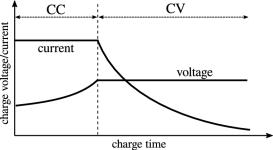Simple question, how to choose charger for a battery pack.
Voltage is "easy" to pick,if u want to charge up to 100%, take your cells max voltage capacity times cells in series. for me it's going to be 4.2*13= 54,6V.
But how to choose current, and why? pros and cons?
BMS: daly 13S 48V 60A. max current charging is not going to be close to reached, it's somewhere in the range 30-60A.
Cells: 91 samsung 18650 26J (13s7p). tested at 2400-2500mah at 1A drain (brand new rated at 2600mah). so the cells are in regards to capacity not far from new
Standard charge is at 1.3A, rapid charge is at 2.6A, max nominal discharge is at 5.2A.
So let me get my thinking out there, if each cell is going to be charged at 1.3A, it comes down to 91*1.3A = 109A at 4.2V, which is around 450Watt. Feeding the bms with 54.6V gets this to a bit over 8A charging current at this voltage.
What if i don't charge them to 100% (4.2V) and i settle with somewhere between 4.0-4.1V, is it an bad idea? or is it a reasonable idea?
What if i don't charge it with the 450Watt, and instead get something slower that might charge them at 200watt, which is just over 0.5A per cell. Is it just going to result in a longer charge time, or can a lower amp have some cons when charging the cells?
This is what i am mostly looking into rn:
https://www.ebay.com/itm/Mean-Well-LRS-350-48-power-supply-350W-48V-7-3A-ultra-flat-30mm-1HU-metal-case/164111779661?epid=669142881&hash=item2635d3074d:g:j24AAOSwkbReYRp9
will be lower than 1.3A per cell, and it will not be 100% charged
350W at maximal 52.6V gives around 1A per cell in charging, and the cells will reach a charge of 4.04V, so about 96% of full charge.
Or am i doing every thinking wrong here and need to rethink everything :lol:
Best Regards! =)
Voltage is "easy" to pick,if u want to charge up to 100%, take your cells max voltage capacity times cells in series. for me it's going to be 4.2*13= 54,6V.
But how to choose current, and why? pros and cons?
BMS: daly 13S 48V 60A. max current charging is not going to be close to reached, it's somewhere in the range 30-60A.
Cells: 91 samsung 18650 26J (13s7p). tested at 2400-2500mah at 1A drain (brand new rated at 2600mah). so the cells are in regards to capacity not far from new
Standard charge is at 1.3A, rapid charge is at 2.6A, max nominal discharge is at 5.2A.
So let me get my thinking out there, if each cell is going to be charged at 1.3A, it comes down to 91*1.3A = 109A at 4.2V, which is around 450Watt. Feeding the bms with 54.6V gets this to a bit over 8A charging current at this voltage.
What if i don't charge them to 100% (4.2V) and i settle with somewhere between 4.0-4.1V, is it an bad idea? or is it a reasonable idea?
What if i don't charge it with the 450Watt, and instead get something slower that might charge them at 200watt, which is just over 0.5A per cell. Is it just going to result in a longer charge time, or can a lower amp have some cons when charging the cells?
This is what i am mostly looking into rn:
https://www.ebay.com/itm/Mean-Well-LRS-350-48-power-supply-350W-48V-7-3A-ultra-flat-30mm-1HU-metal-case/164111779661?epid=669142881&hash=item2635d3074d:g:j24AAOSwkbReYRp9
will be lower than 1.3A per cell, and it will not be 100% charged
350W at maximal 52.6V gives around 1A per cell in charging, and the cells will reach a charge of 4.04V, so about 96% of full charge.
Or am i doing every thinking wrong here and need to rethink everything :lol:
Best Regards! =)



